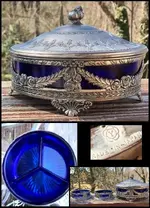You are using an out of date browser. It may not display this or other websites correctly.
You should upgrade or use an alternative browser.
You should upgrade or use an alternative browser.
Help with hallmark please
- Thread starter BuckIdgr
- Start date
- Joined
- Dec 23, 2019
- Messages
- 6,392
- Reaction score
- 20,314
- Golden Thread
- 0
- Location
- Surrey, UK
- Primary Interest:
- All Treasure Hunting
I'm afraid that's not a hallmark and your piece is not silver. The same (Y in a 'flower') mark appears on this vintage piece:

I don't know the maker (neither does the seller), but it also says "Made in Japan" on the bottom, so it was exportware for the Western market. The seller describes it as "pewter" but I would think more likely plated antimony or spelter... as yours might well be.

I don't know the maker (neither does the seller), but it also says "Made in Japan" on the bottom, so it was exportware for the Western market. The seller describes it as "pewter" but I would think more likely plated antimony or spelter... as yours might well be.
Upvote
0
BuckIdgr
Jr. Member
- #3
Thread Owner
I'm afraid that's not a hallmark and your piece is not silver. The same (Y in a 'flower') mark appears on this vintage piece:
View attachment 1900655
I don't know the maker (neither does the seller), but it also says "Made in Japan" on the bottom, so it was exportware for the Western market. The seller describes it as "pewter" but I would think more likely plated antimony or spelter... as yours might well be.
Thank you for the information, I was always told it was Silver. Now I know.
Upvote
0
Plug N Play
Bronze Member
- Joined
- Aug 23, 2014
- Messages
- 1,315
- Reaction score
- 3,573
- Golden Thread
- 0
- Location
- California
- Detector(s) used
- De Havilland Canada DHC-7-102 Dash 7 - Fugro
- Primary Interest:
- All Treasure Hunting
This three piece, $160 set, says ornate silver plate in the title.
Their description says Country of Manufacture : unknown,
while showing a picture that says "Made in Japan"
https://www.ebay.com/itm/VINTAGE-JA...GLASS-COVERED-DISH-PLUS-2-SALTS-/123001586975

Their description says Country of Manufacture : unknown,
while showing a picture that says "Made in Japan"

https://www.ebay.com/itm/VINTAGE-JA...GLASS-COVERED-DISH-PLUS-2-SALTS-/123001586975

As an eBay Associate we earn from qualifying purchases.
Upvote
0
- Joined
- Dec 23, 2019
- Messages
- 6,392
- Reaction score
- 20,314
- Golden Thread
- 0
- Location
- Surrey, UK
- Primary Interest:
- All Treasure Hunting
This three piece, $160 set, says ornate silver plate in the title.
Their description says Country of Manufacture : unknown,
while showing a picture that says "Made in Japan"
https://www.ebay.com/itm/VINTAGE-JA...GLASS-COVERED-DISH-PLUS-2-SALTS-/123001586975
Yes... one has to be careful about what fleabay sellers say about their items, which is why I chose my words carefully. It is obviously a Japanese mark but could be for the maker or the importer/agent outside Japan who commissioned the pieces. I didn't say it wasn't plated, but the mark is not a hallmark and the piece is not silver. If it is plated it will be on some kind of base metal alloy. High antimony alloys (a kind of pewter in a sense) and zinc spelters of various compositions were commonly used for Japanese export items like this... both plated and unplated.
As an eBay Associate we earn from qualifying purchases.
Upvote
0
WannaDig3687
Platinum Member
Well, I was "coaching" BuckIdgr on how to make a post. So, the choice of the word "Hallmark" Was my ineptitude. This inherited piece (and there are several) was one with a mark that we tried to research on our own, unsuccessfully. After reading your post, redcoat, I took another good hard look at it, and I still couldn't find "made in" anywhere on it. The oral history is that it came from Germany. Well, I suppose it could have been bought there, yet still made in Japan. Or, simply just misinformation given to someone. You have pointed me down another rabbit hole and I still have come out empty handed. But, still, you have both given us more information than we had to begin with. Thank you.
Upvote
0
- Joined
- Dec 23, 2019
- Messages
- 6,392
- Reaction score
- 20,314
- Golden Thread
- 0
- Location
- Surrey, UK
- Primary Interest:
- All Treasure Hunting
Well, I was "coaching" BuckIdgr on how to make a post. So, the choice of the word "Hallmark" Was my ineptitude. This inherited piece (and there are several) was one with a mark that we tried to research on our own, unsuccessfully. After reading your post, redcoat, I took another good hard look at it, and I still couldn't find "made in" anywhere on it. The oral history is that it came from Germany. Well, I suppose it could have been bought there, yet still made in Japan. Or, simply just misinformation given to someone. You have pointed me down another rabbit hole and I still have come out empty handed. But, still, you have both given us more information than we had to begin with. Thank you.
It would help if we could identify that 'Y' mark. I'll keep looking, but I'm sure it will be Japanese-related. Japanese items exported to Germany would not have a 'Made in Japan' indication in English, I think.
Whether or not goods are marked with country of origin depends greatly on when the item was made and the laws of the country to which the item was destined to be exported. Britain started the ball rolling with “The Merchandise Marks Act 1887” to prevent foreign manufacturers from falsely claiming that their goods were British-made and selling them in Britain and Europe on that pretence.
America followed suit with the McKinley Tariff Act, effective from March 1891. All goods imported to the U.S. were required to be marked in English with the country of origin… eg “Japan” (and “Nippon” was also an accepted term). In 1914 the act was amended, requiring the addition of the words "Made In…" plus the country of origin but this was not rigorously enforced until around 1921. Some exporters adopted the required wording before it became mandatory, but that was the exception rather than the rule.
Also, in August 1921 it was ruled that “Nippon” was no longer an acceptable indication and that only “Japan” could be used. There were no imports from Japan between 1941-1945, for obvious reasons, and they didn't resume until the late summer of 1947. From then, the required marking was "Occupied Japan" or "Made in Occupied Japan" until 1949, at which time it was decreed that "Occupied Japan", "Made in Occupied Japan", "Made in Japan" or just "Japan" were all acceptable. That continued until 1952 when occupation ended and the requirement switched back to "Japan" or "Made in Japan".
After the war there was continuing “anti-Japanese” sentiment to the extent that many American consumers wouldn’t buy Japanese goods and sometimes they were stigmatised as inferior. For a while, some manufacturers used adhesive foil labels to fulfil the origin marking requirements at time of import, with the advantage that the labels could be peeled off by the purchaser (or, unscrupulously, by the retailer).
Upvote
0
WannaDig3687
Platinum Member
It would help if we could identify that 'Y' mark. I'll keep looking, but I'm sure it will be Japanese-related. Japanese items exported to Germany would not have a 'Made in Japan' indication in English, I think.
Whether or not goods are marked with country of origin depends greatly on when the item was made and the laws of the country to which the item was destined to be exported. Britain started the ball rolling with “The Merchandise Marks Act 1887” to prevent foreign manufacturers from falsely claiming that their goods were British-made and selling them in Britain and Europe on that pretence.
America followed suit with the McKinley Tariff Act, effective from March 1891. All goods imported to the U.S. were required to be marked in English with the country of origin… eg “Japan” (and “Nippon” was also an accepted term). In 1914 the act was amended, requiring the addition of the words "Made In…" plus the country of origin but this was not rigorously enforced until around 1921. Some exporters adopted the required wording before it became mandatory, but that was the exception rather than the rule.
Also, in August 1921 it was ruled that “Nippon” was no longer an acceptable indication and that only “Japan” could be used. There were no imports from Japan between 1941-1945, for obvious reasons, and they didn't resume until the late summer of 1947. From then, the required marking was "Occupied Japan" or "Made in Occupied Japan" until 1949, at which time it was decreed that "Occupied Japan", "Made in Occupied Japan", "Made in Japan" or just "Japan" were all acceptable. That continued until 1952 when occupation ended and the requirement switched back to "Japan" or "Made in Japan".
After the war there was continuing “anti-Japanese” sentiment to the extent that many American consumers wouldn’t buy Japanese goods and sometimes they were stigmatised as inferior. For a while, some manufacturers used adhesive foil labels to fulfil the origin marking requirements at time of import, with the advantage that the labels could be peeled off by the purchaser (or, unscrupulously, by the retailer).
That would be the rabbit hole I went down. May be too many variables to find an answer. Thanks for the information and help and learning experience.
Upvote
0
Similar threads
Users who are viewing this thread
Total: 1 (members: 0, guests: 1)





